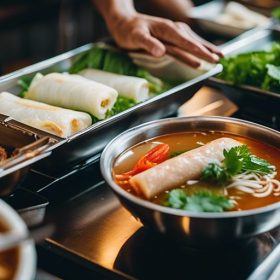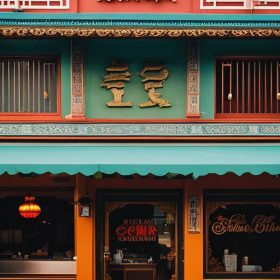Vietnam’s street food culture is renowned worldwide for its vibrant flavors, diverse ingredients, and bustling atmosphere. From the busy streets of Hanoi to the vibrant markets of Ho Chi Minh City, street food vendors can be found on every corner, offering a wide array of delicious dishes. Street food is not just a way to grab a quick bite to eat; it is an essential part of Vietnamese cuisine and culture.
In Vietnam, street food is deeply ingrained in the daily lives of locals. It is a way for people to connect with their community, share stories, and enjoy delicious food together. The streets come alive with the sights, sounds, and smells of sizzling pans, steaming pots, and fragrant herbs. Whether it’s a bowl of pho, a banh mi sandwich, or a plate of fresh spring rolls, street food in Vietnam offers a sensory experience like no other.
The Best Time to Sample Street Food in Vietnam
The ideal time of day to try street food in Vietnam is during the evening when the streets come alive with food stalls and vendors. As the sun sets, the air becomes cooler, and the aromas of grilled meats, spices, and herbs fill the air. This is when locals and tourists alike flock to the streets to indulge in their favorite street food dishes.
The best season to visit Vietnam for street food depends on personal preference. However, many travelers recommend visiting during the cooler months from November to February when the weather is more pleasant and comfortable for exploring the bustling streets. During this time, you can enjoy hot bowls of pho or steaming bowls of bun cha without feeling overwhelmed by the heat.
Top 5 Must-Try Street Food Dishes in Vietnam
1. Pho: Pho is perhaps one of the most iconic Vietnamese dishes and a must-try when visiting Vietnam. It is a flavorful noodle soup made with rice noodles, tender slices of beef or chicken, and a fragrant broth infused with spices like star anise, cinnamon, and cloves. Pho can be found in almost every street corner in Vietnam, but some of the best places to try it include Pho Gia Truyen in Hanoi and Pho Thin in Ho Chi Minh City.
2. Banh Mi: Banh Mi is a Vietnamese sandwich that combines French and Vietnamese flavors. It is made with a crusty baguette filled with various ingredients such as grilled pork, pate, pickled vegetables, fresh herbs, and a drizzle of mayonnaise or chili sauce. Banh Mi 25 in Hoi An and Banh Mi Huynh Hoa in Ho Chi Minh City are known for serving some of the best banh mi in Vietnam.
3. Bun Cha: Bun Cha is a popular street food dish in Hanoi that consists of grilled pork patties served with vermicelli noodles, fresh herbs, pickled vegetables, and a sweet and tangy dipping sauce. One of the best places to try bun cha is at Bun Cha Huong Lien, also known as “Obama Bun Cha,” where former US President Barack Obama famously dined during his visit to Vietnam.
4. Goi Cuon: Goi Cuon, also known as fresh spring rolls, are a refreshing and healthy street food option. They are made by wrapping rice paper around a combination of fresh herbs, vermicelli noodles, shrimp or pork, and sometimes tofu or vegetables. Goi Cuon can be found at many street food stalls throughout Vietnam.
5. Com Tam: Com Tam is a popular street food dish in Ho Chi Minh City that translates to “broken rice.” It is made with broken rice grains topped with grilled pork chops, shredded pork skin, a fried egg, pickled vegetables, and a side of fish sauce. Com Tam Ba Ghien and Com Tam Cali are two well-known places to try this dish.
Navigating the bustling street food markets of Vietnam can be an overwhelming experience, but with a few tips, you can make the most of your culinary adventure.
When ordering street food, it’s important to be patient and observe how the locals do it. Many street food vendors have a specific system in place, so watch how others order and follow suit. It’s also helpful to learn a few basic Vietnamese phrases to communicate with the vendors.
When it comes to paying for street food, cash is king. Most street food vendors in Vietnam only accept cash, so make sure to have small bills on hand. It’s also customary to pay for your food immediately after receiving it.
To find the best street food vendors, look for places that are crowded with locals. This is usually a good sign that the food is fresh and delicious. Don’t be afraid to ask locals for recommendations or join a street food tour led by a knowledgeable guide who can take you to the best spots.
The Secret Ingredients That Make Vietnam’s Street Food So Delicious
Vietnam’s street food is known for its bold and complex flavors, thanks to the use of various secret ingredients. Some common ingredients used in Vietnamese street food include fish sauce, lemongrass, chili peppers, fresh herbs like mint and cilantro, and condiments like soy sauce and hoisin sauce.
Fish sauce is a staple ingredient in Vietnamese cuisine and is used as a base for many dishes. It adds a savory umami flavor that enhances the taste of meats, vegetables, and noodles. Lemongrass adds a citrusy aroma and flavor to dishes like grilled meats and soups.
Chili peppers are used to add heat and spice to many Vietnamese dishes. They can be found in sauces, marinades, and as a garnish. Fresh herbs like mint, cilantro, and Thai basil are used to add freshness and brightness to dishes. They are often served as a side dish or used as a garnish.
The History and Culture Behind Vietnam’s Street Food
The origins of street food in Vietnam can be traced back to the country’s long history of trade and migration. Street food vendors have been a part of Vietnamese culture for centuries, serving quick and affordable meals to locals and travelers alike.
Street food in Vietnam reflects the country’s rich culinary heritage and diverse regional cuisines. Each region has its own unique street food specialties, influenced by the local ingredients and flavors. For example, in the north, you’ll find dishes like pho and bun cha, while in the south, you’ll find dishes like banh mi and com tam.
Street food also plays a significant role in Vietnamese social culture. It is a way for people to come together, share a meal, and connect with their community. Street food stalls often become gathering places where friends and family meet to enjoy delicious food and engage in lively conversations.
Vegetarian and Vegan Options in Vietnam’s Street Food Scene
Vietnam’s street food scene offers plenty of options for vegetarians and vegans. Many traditional Vietnamese dishes can be easily modified to be vegetarian or vegan-friendly by substituting meat with tofu or vegetables.
One popular vegetarian street food dish is Banh Xeo Chay, which is a vegetarian version of the traditional Vietnamese pancake. It is made with a rice flour batter filled with mushrooms, bean sprouts, and other vegetables.
Another popular option is Banh Mi Chay, which is a vegetarian version of the banh mi sandwich. It is made with tofu or seitan instead of meat and filled with pickled vegetables, fresh herbs, and chili sauce.
Vegetarian and vegan street food options can be found at many street food stalls and markets throughout Vietnam. It’s always a good idea to communicate your dietary restrictions to the vendor to ensure that your food is prepared without any animal products.
Street Food Safety Tips for Travelers in Vietnam
While street food in Vietnam is delicious, it’s important to take precautions to avoid getting sick. Here are some street food safety tips for travelers:
1. Choose busy stalls: Look for street food stalls that are crowded with locals. This is usually a sign that the food is fresh and safe to eat.
2. Observe hygiene practices: Pay attention to how the food is prepared and handled. Make sure the vendor uses clean utensils and practices good hygiene.
3. Eat cooked food: Opt for cooked dishes rather than raw or uncooked ones, as they are less likely to cause foodborne illnesses.
4. Avoid tap water: Stick to bottled water or drinks that are made with boiled water to avoid consuming contaminated tap water.
5. Trust your instincts: If something doesn’t look or smell right, it’s best to avoid it. Trust your instincts and choose another vendor.
The Best Street Food Tours and Guides in Vietnam
If you’re looking for a guided street food experience in Vietnam, there are plenty of options available. Many tour companies offer street food tours led by knowledgeable guides who can take you to the best street food spots and provide insights into Vietnamese cuisine and culture.
Some popular street food tours include the Hanoi Street Food Tour, the Saigon Street Food Tour, and the Hue Street Food Tour. These tours typically include visits to local markets, street food stalls, and restaurants where you can sample a variety of dishes.
When choosing a street food tour or guide, it’s important to read reviews and do some research beforehand. Look for tours that have positive feedback from previous customers and offer a good balance of food, culture, and history.
How to Cook Authentic Vietnamese Street Food at Home
If you want to recreate the flavors of Vietnamese street food at home, here are a few recipes to get you started:
1. Pho: To make pho at home, you’ll need beef or chicken broth, rice noodles, thinly sliced beef or chicken, and various spices like star anise, cinnamon, and cloves. Simmer the broth with the spices for a few hours to infuse the flavors, then cook the noodles and meat separately. Serve the pho with fresh herbs, bean sprouts, lime wedges, and chili sauce.
2. Banh Mi: To make banh mi at home, you’ll need a crusty baguette, grilled pork or tofu, pickled vegetables (carrots and daikon radish), fresh herbs (cilantro and Thai basil), and condiments like mayonnaise and chili sauce. Slice the baguette in half, spread the condiments on one side, then layer the grilled pork or tofu, pickled vegetables, and fresh herbs on top.
3. Bun Cha: To make bun cha at home, you’ll need ground pork patties, vermicelli noodles, fresh herbs (mint and cilantro), pickled vegetables (carrots and daikon radish), and a sweet and tangy dipping sauce. Grill the pork patties until cooked through, then serve them with cooked vermicelli noodles, fresh herbs, pickled vegetables, and the dipping sauce.
The Unforgettable Experience of Vietnam’s Street Food Adventure
Sampling street food in Vietnam is not just about satisfying your hunger; it’s an unforgettable experience that allows you to immerse yourself in the country’s vibrant culinary culture. From the bustling streets of Hanoi to the vibrant markets of Ho Chi Minh City, Vietnam’s street food scene offers a wide array of delicious dishes that will tantalize your taste buds and leave you craving for more.
Whether you’re slurping a bowl of pho, biting into a banh mi sandwich, or savoring the flavors of bun cha, each bite tells a story of Vietnam’s rich culinary heritage. The combination of fresh ingredients, bold flavors, and the bustling atmosphere of the streets creates a sensory experience like no other.
So, when you visit Vietnam, make sure to explore the vibrant street food scene and indulge in the flavors that have captivated locals and travelers for generations. It’s an adventure that will leave you with lasting memories and a deep appreciation for the culinary treasures of Vietnam.

Cuong Nguyen is a talented writer and experienced waitress at Vietnampalace.net, a renowned Vietnamese restaurant that offers an extensive menu of authentic Vietnamese cuisine. With a background in the competition of Vietnamese cuisine, Cuong brings a wealth of knowledge and expertise to the dining experience. From delicious pho dishes to fresh spring rolls, Cuong ensures that every meal is made with the freshest ingredients and authentic flavors.With exceptional service and a friendly atmosphere, Cuong takes pride in providing a memorable dining experience for every customer.
Whether you’re a vegetarian looking for options or a meat lover craving the flavors of traditional Vietnamese dishes, Cuong guarantees a delightful culinary adventure. So, visit Vietnampalace.net and let Cuong guide you through the tantalizing world of Vietnamese cuisine.



